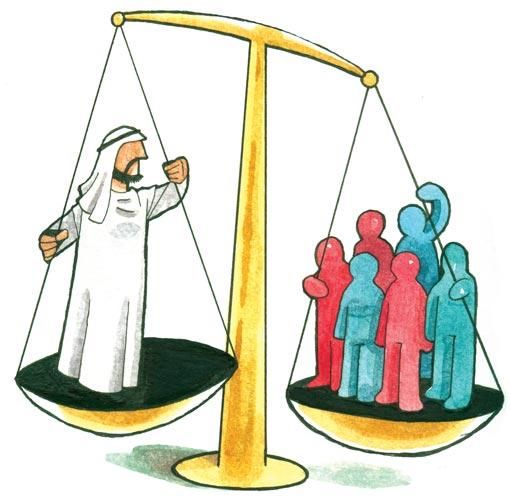The issue of Emiratisation is once again in focus with the Ministry of Labour (MoL) publishing a special report on current employment conditions in the local labour market.
At the end of 2007, the number of Emiratis in the UAE labour market stood at 11,233, or 0.34 per cent of the total employees registered at the ministry, as against some 3,250,000 foreign employees from 202 countries.
The number of national employees at the time included 6,180 women, or 55 per cent of the total national work force. Only about 30 per cent of the total number of nationals had any educational qualifications other than their high school certificates. In the meantime, however, the number of foreign employees in the private sector has increased at approximately 18 per cent annually (as per MoL estimates).
Main hurdles
According to the MoL, there are two main reasons keeping national employees from making an impact in the private sector: the first is the ever increasing number of expatriates entering the local labour market and the second can be traced to a small basket of sectors that go with the culture and needs of nationals.
It is important to clarify that the UAE is not the only country in the Arabian Gulf faced with the challenge of managing a workforce where the huge majority are foreign workers.
Certain countries have adopted policies aimed at increasing the number of national employees in both public and private sectors.
In addition to the UAE, Saudi Arabia, Kuwait and Oman have implemented various programmes to replace expatriates with nationals. Also, these countries have been attempting to provide employment opportunities for the increasing number of nationals graduating from higher education institutions.
In the UAE, the emphasis of the Emiratisation policy was to bring about a marked shift in the representation of national employees, particularly in the private sector. Official statistics point to three important facts.
Firstly, the national and expatriate workforces accounted for about 9.3 per cent and 90.7 per cent respectively in 2004 (Tanmia, 2005). I believe these numbers have changed drastically over the last three years in favour of foreign workers.
Secondly, by the end of the 2003/04 academic year, UAE nationals comprised the majority of higher education graduates, making up 8,661 or 66 per cent of 13,143 graduates from higher education institutions (Tanmia, 2005).
Thirdly, between 2000 and April 2005, approximately 29,682 UAE nationals have registered at the National Human Resources Development and Employment Authority, known as Tanmia, seeking to find appropriate jobs.
This number included 24,020 nationals who had never taken up a job. In addition, there were approximately 11,700 who had graduated from higher education institutions and acquired additional degrees.
Since the 1980s, the UAE government has been seriously trying to address the demographic imbalances in the labour market and to bring about a positive change through higher education.
Hence, the policy of Emiratisation was gradually introduced at the federal level and some emirates followed it up with local initiatives.
Government influence
Within this perspective, there have been many initiatives that have sought to encourage the private sector to train and recruit local talent.
Between the1980s and 1997, several steps were taken by the Ministry of Labour in order to regulate employment relationships, to emphasise that nationals were to be accorded priority for openings in the private sector, and to bring private industries to absorb nationals who successfully completed training courses they had offered.
In 1997 and 1999, the UAE took two major steps within the larger policy of Emiratisation. The first was establishing the Committee for Human Resources Development in the Banks Sector (CHRDB) which aimed to have 50 per cent of banking jobs performed by UAE citizens by the year 2007. The second impetus came in 1999, with a Presidential Decree establishing Tanmia, which focuses on developing capabilities and skills of local manpower in order to bring about the desired balance in the labour market.
Meanwhile, some emirates have established local authorities to encourage Emiratisation. The Abu Dhabi Emiratisation Council and the Emirates National Development Programme in Dubai are prime examples.
It is obvious that the UAE government has been attempting to enforce the policy of Emiratisation in order to avoid strategic challenges that could hold out implications for national and economic stability further down the line.
However, from my point of view, the situation continues to be alarming even as both cause and cure continue to be vested in the hands of the Ministry of Labour.
The MoL is the only federal authority that provides work permits and, therefore, it can play a strategic role in implementing the policy of Emiratisation. The MoL can exercise control on the number of new work permits being issued and also release statistics on a regular basis to help decision-makers and researchers evaluate developments in the labour market that affect the policy of Emiratisation.
It is a fact that Emiratisation needs a national strategy that unifies all federal and local efforts but we can not ignore the fact that the increasing number of work permits issued remains the one factor that flies in the face of the policy.
I believe the situation calls for a national strategy. The MoL needs to establish a strategic relationship with the Ministry of Interior, Tanmia and other local Emiratisation organisations besides higher education institutions to ensure that the policy is realised in its full scope.
Abdullah Al Shaiba is a UAE national academic and thinker










